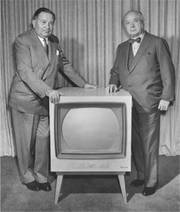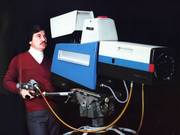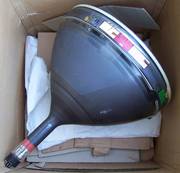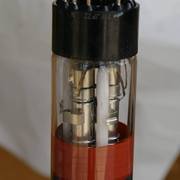The NTSC Color Television Standards (December, 1953)
Originally published as a Report from Panel 12 of the "National Television System Committee" in “Color Systems Analysis.” (entnommen aus einer RCA Publication von 1954)
Aus einer RCA Publication von 1954 - INTRODUCTION
THE NTSC COLOR television standards are designed to meet two basic requirements:
- (1) to provide the best color television service possible within the standard 6 mc television channel, and
- (2) to provide a color signal which will produce a high quality monochrome image on existing black-and-white television receivers, without requiring any change whatever in such receivers.
.
These aims are achieved by transmitting two signals, one identical in all essential respects to the black-and-white television signal, the other (the “chromatic signal”) carrying two types of color information which jointly represent the chromatic values of the scene. By using multiplex techniques these signals are sent simultaneously over the channel of the television station.
.
When a conventional black-and-white receiver is tuned to transmissions conforming to the NTSC color standards the receiver responds fully to the first signal (the “brightness signal”) and recreates from it an image in black-and-white having a quality equal (or superior) to that provided by present black-and-white standards. Because of the nature of the chromatic signal, no normally perceptible effect is produced by it in the black-and-white image on such a receiver.
The color receiver, however, responds to both signals, and the chromatic signal is then used specifically to recreate in the image the color values lacking in the brightness signal. Moreover, when the chromatic signal is absent, as when the color receiver is tuned to a black-and-white transmission, the receiver produces without any change or adjustment, an image in black-and-white.
In this manner, compatibility is achieved between color broadcasts and the black-and-white broadcasts. The black-and-white receiver produces black-and-white images from either type of broadcast and the color produces images, according to the type of broadcast, in color or in black-and-white.
Es gibt inzwischen mehr Informationen zur RCA
Diese Infos lesen Sei bei den US-Magazinen und in der Fernseh-Historie.
.
BASIS OF THE NTSC COLOR STANDARDS
The technical basis of the NTSC color standards lies in the science of color measurement (colorimetry). Those concerned with the matching of colors, for example those engaged in color printing and color photography, have for many years recognized that the color of an object can be identified by three quantities representative of its brightness, its hue and its saturation.
The brightness is a measure of the lightness or darkness of a color; the hue specifies whether the color is red, or blue, or yellow, for example; and saturation is a measure of the mixture of this hue with white light. The hue and saturation values together represent the chromatic values of the color.
When a scene is photographed with black-and-white film, the film responds only to brightnesses in the scene, while the chromatic values of the colors are lost. When the same scene is photographed with color film, three individual images are recorded, one in each of the three primary colors in proper proportion, the chromatic values (hues and saturations) of the colors are preserved and can be made available in the color print or transparency.
Photographic technicians have, in fact, produced experimental photographs which are somewhat analogous to the two signals of the NTSC color standards, one photograph (in black-and-white) showing only the brightness values on the scene, and another (in color but having equal brightness at every point) indicating only the chromatic values present. The NTSC color standards define an electrical process for achieving the same result. The essential elements of this system are outlined in the following paragraphs.
The Color Camera and Tricolor Picture Tube
The apparatus suitable for the NTSC standards is conveniently divided into two more or less independent groups, the terminal equipment (camera at the transmitter and picture tube at the receiver) and the transmission equipment which carries the television signal from one terminal to the other.
A color camera suitable for the NTSC color standards may incorporate three image-orthicon camera tubes similar to the camera tubes used in black-and-white broadcasting. Each of the tubes is fitted with a color filter (transparent colored glass), in such a way that one camera tube receives an image in red light, the second an image in green light and the third in blue light. In this manner the color values of the scene are analyzed into three primary colors. The three camera tubes are so mounted that they view the scene from the same vantage point. Therefore, the three primary color images have the same geometric form, but differ in the color of the light. In the camera tubes, each image is converted into a corresponding electrical signal.
The color camera thus produces three signals, each representing the same scene, but differing according to the colors present in the scene. For example, in representing the white and gray parts of the scene, all three signals are active (since white or gray light is produced by a combination of all three primary colors). In red parts of the scene, the red primary signal is predominant; in yellow parts, both red and green signals are strong (since yellow light is produced by a combination of red and green lights), and so on.
The picture reproducer
The opposite terminal of the color television system is the picture reproducer. To it are fed three signals similar to those generated by the camera, producing corresponding images in red, green, and blue light. A typical picture reproducer suitable for the NTSC color standards is the tricolor picture tube. In one form of tricolor tube the viewing screen consists of several hundred thousand individual phosphor dots of three different types. One set of dots produces red light, a second set, green light, and the third, blue light. The dots are uniformly interspersed on the viewing screen, so that dots of different color are adjacent, but do not overlap. This arrangement of colored dots is similar to that used in color printing.
To excite the phosphor dots, three electron beams are formed at the opposite end of the tube. The internal structure of the picture tube is so arranged that one electron beam is constrained to fall only on the red dots, the second beam only on the green dots, and the third only on the blue dots.
To recreate the image in full color, the three electron beams are produced simultaneously, forming three primary-color images consisting of dots so interspersed that the images occupy the same space on the viewing screen. The dot structure is so fine that it is not perceptible as such at normal viewing distances. Consequently the three images appear to be superimposed and the primary colors combine to reproduce the image in full color.
The three electron beams move (“scan”) over the viewing screen in the same manner as the corresponding electron beams in the camera tubes of the color camera previously described. Thus, if the camera tube viewing the scene through the red filter is caused to control the beam in the tricolor tube which excites the red dots, the red colors in the image correspond to the red colors in the scene. A similar connection is provided between the blue camera tube and the blue dots, and between the green camera tube and the green dots.
In brief, the three camera tubes generate three signals which, transmitted to the picture tube, recreate three corresponding primary-color images, superimposed on the viewing screen.
The Transmission Process—Signal Transformation
From the foregoing, it would appear that the transmission system connecting camera and picture tube should carry three signals representing the red, green, and blue primary-color values in the scene to be reproduced. But this simple one-to-one correspondence between images and signals has two important disadvantages: First, no one of these three signals is ideally suited to the operation of black-and-white receivers; a preferable arrangement involves a signal (the brightness signal previously mentioned) particularly designed to operate black-and-white receivers.
Second, and more important, the transmission of these three signals does not make the most efficient use of a television channel. The characteristics of human vision are such that, to use the channel most efficiently, the three signals should be transmitted in a preferential way, so that one signal (the brightness signal) is accorded the major width of the channel, while the other signals (which together represent chromatic values) are given less channel width.
The transformation from the primary-color signals produced by the color camera to the preferentially-treated brightness and chromatic signals is readily performed in the electronic circuits. If the primary-color signals are fed to such a circuit a signal representative of brightness, and a pair of signals representing the chromatic values are produced. At the color receiver a similar circuit transforms the brightness and chromatic signal into the primary-color signals suitable for controlling the three electron beams in the tricolor picture tube.
Simultaneous Transmission of Brightness and Chromaticity Signals
The remaining problem is the simultaneous transmission of the brightness signal and the chromatic signal on the same channel without mutual interference. This technique can be explained briefly by reference to the method of transmitting a television image by means of radio. All radio transmissions involve a high-frequency wave known as a “carrier” which is “modulated” (caused to vary) in accordance to the program or other information to be transmitted.
In amplitude modulation (AM) the power of the carrier wave is varied; in frequency modulation (FM) the frequency of the wave changes. In addition to these well known methods of modulation a third may be used, known as phase modulation (PM). Phase modulation and frequency modulation are intimately related: one may readily be derived from the other.
In the NTSC color standards the chromatic signal modulates a so-called “color carrier.” The pair of signals previously mentioned as jointly representing the chromatic values are applied together to the color carrier to modulate it. The two signals are so applied to the color carrier that the carrier is modulated in two ways, in amplitude and in phase.
By thus modulating the color carrier in two ways simultaneously, two signals representing the chromatic values can be carried without loss of identity, provided that proper timing is maintained between the modulation process at the transmitter and the inverse “demodulation” process at the receiver. This latter requirement is met by sending to the receiver, along with the television synchronizing pulses, a timing signal known as the color-phase signal. This causes the receiver chromatic signal circuits to operate in synchronism with those at the transmitter.
The brightness signal is transmitted in a manner exactly like that used in transmitting an image over a black-and-white transmitter. Consequently the quality associated with the brightness values in the received color image is at least equal to that of the black-and-white system and, for the same reason, reception of the color signal on black-and-white receivers is of high quality.
It then remains to arrange the chromatic signal and the brightness signal so that they utilize the channel assigned to the transmitter without undue interference. This problem is simplified by the fact that, as a result of the scanning process used in dissecting and reassembling the image, the brightness signal components are concentrated in uniformly spaced intervals across the channel. The chromatic signal is concentrated in a similar fashion, since it arises from the same scanning process.
It is feasible to shift the concentrations in the spectrum of the chromatic signal so that they fall between those of the brightness signal spectrum. This is accomplished by choosing the frequency of the color carrier as an odd multiple of one-half of the line frequency. In this manner, the whole of the spectrum assigned to the picture transmission is more completely occupied, and the two sets of signals are transmitted simultaneously without one interfering unduly with the other. That this is so is due to the fact that, with the particular choice of carrier frequency, the unwanted signal received with a certain phase in one field will be received with the opposite phase in a succeeding field, 1/30 of a second later.
Another factor which eliminates interference is inherent in the transmission of the brightness and chromatic signals as separate entities. Whenever a substantial portion of the televised scene appears in shades of gray or white, as previously noted, all three primary colors are active in the camera and picture tube. But in transforming the primary-color signals to brightness and chromatic signals, only one signal, the brightness signal, appears from such gray and white portions of the screen. Since the chromatic signal is then absent, there is no opportunity for interference to exist in such portions of the scene.
The over-all result is that the NTSC color television standards are capable of providing a high quality color picture with definition equal to that of present black-and-white pictures, and of producing a higher quality monochrome image on existing black-and-white receivers, without requiring any change whatever in such receivers.
The NTSC Color Television Standards (December, 1953)
.





